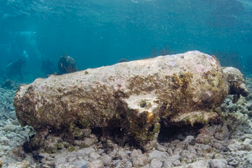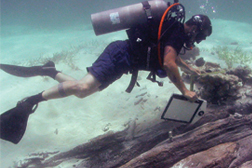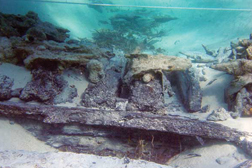 |
|||||||||
skip to content |
|||||||||
NOAA-supported mission discovers historic shipwrecks off Turks and Caicos Islands
Maritime archaeologists have identified the wrecks of two historic ships, including the slave ship Trouvadore, off the coast of East Caicos in the Turks and Caicos Islands after several years of archaeological research funded by NOAA's Office of Ocean Exploration and Research. Don Keith and Toni Carrell, from the underwater archaeology research institute Ships of Discovery, were able to identify the Trouvadore 167 years after it struck a reef in 1841 while en route to Cuba.
When she sunk, the Spanish vessel Trouvadore was participating in the slave trade, which had been outlawed in the Turks and Caicos Islands and the rest of the British Indies. After Trouvadore struck the reef, authorities arrested the crew, and most of the 192 African survivors settled on Grand Turk Island. At that time, they represented one of every 15 people on that island, and many of Grand Turk's current residents are likely descendents of Trouvadore survivors.
"Although the sinking of the Trouvadore was a major event on the Island, the story was lost to history over the following century and a half," said Carrell. "After we uncovered records of the shipwreck several years ago, we were stunned to realize that Turks and Caicos residents had never heard of the shipwreck that brought their ancestors to the Island."

This heavily concreted carronade is one of 10 located during the 2008 expedition. It is the proverbial "smoking gun" – the clue that every archaeologist hopes to find that will positively identify a site. By measuring the inside diameter, archaeologists confirmed that these were 32-pounder carronades, the size used on the Chippewa. Image courtesy of 2008: Search for the Slave Ship Trouvadore/NOAA
Keith and Carrell knew from the start it would be difficult to find artifacts to identify the ship. "People of these islands traditionally have used resources from sunken ships. There are houses built on Grand Turk from ship remains," said Keith. "We knew the ship had been salvaged upon sinking, and we weren't going to find a bell with ‘Trouvadore 1841' on it."

The hull remains of the so-called “Black Rock Wreck” were measured and compared to the dimensions of known shipwrecks off East Caicos. Through a meticulous process of elimination, the archaeological team was able to rule out all of the ships except the Spanish slave ship Trouvadore. Image courtesy of 2008: Search for the Slave Ship Trouvadore/NOAA.
Keith and Carrell believe the African survivors of the Trouvadore are the ancestors of a large portion of current residents in the Turks and Caicos Islands. For example, traditions on the Islands have a recognizable African origin. The Turks and Caicos National Museum is recording these traditions through oral histories and is educating the community about their ancestral history.

The position of two large wooden deadeyes helped to confirm the location of the master frame. Deadeyes were attached outside the hull to stabilize masts and keep them from moving “side to side” in the ship. They are called “deadeyes” because they look like a skull with eye sockets and a mouth. Image courtesy of 2008: Search for the Slave Ship Trouvadore/NOAA.
"What makes a people different and distinct is their unique history," said Keith, who has worked in the islands for 30 years. "The people of the Turks and Caicos have a direct line to this dramatic, historic event – it's how so many of them ended up being there. We hope this discovery will encourage the people of the Turks and Caicos to protect and research their local history, especially the history that remains underwater."

View of the Trouvadore’s keel, garboard and frames from starboard side. A large sheet of copper sheathing studded with tacks lies in foreground. Image courtesy of Search for Trouvadore science team/NOAA.
On the web at: www.oceanexplorer.noaa.gov/explorations/08Trouvadore/welcome.html
11/07/08
CLIMATE · OCEANS, GREAT LAKES, and COASTS · WEATHER
and AIR QUALITY
ABOUT US · RESEARCH
PROGRAMS · EDUCATION · HOME